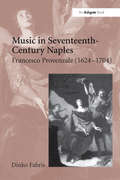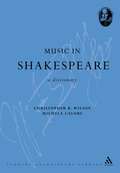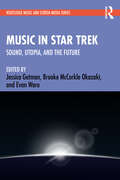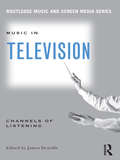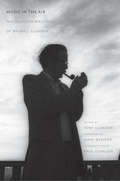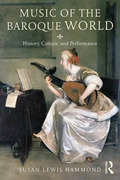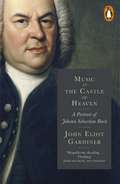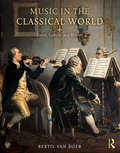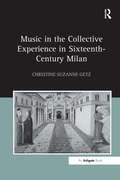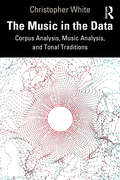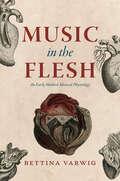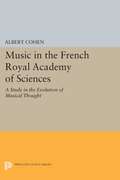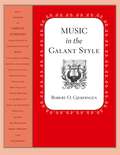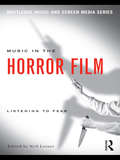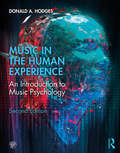- Table View
- List View
Music in Seventeenth-Century Naples: Francesco Provenzale (1624-1704)
by Dinko FabrisThe most important figure of seventeenth-century Neapolitan music, Francesco Provenzale (1624-1704) spent his long life in the service of a number of Neapolitan conservatories and churches, culminating in his appointment as maestro of the Tesoro di S. Gennaro and the Real Cappella. Provenzale was successful in generating significant profit from a range of musical activities promoted by him with the participation of his pupils and trusted collaborators. Dinko Fabris draws on newly discovered archival documents to reconstruct the career of a musician who became the leader of his musical world, despite his relatively small musical output. The book examines Provenzale's surviving works alongside those of his most important Neapolitan contemporaries (Raimo Di Bartolo, Sabino, Salvatore and Caresana) and pupils (Fago, Greco, Veneziano and many others), revealing both stylistic similarities and differences, particularly in terms of new harmonic practices and the use of Neapolitan language in opera. Fabris provides both a life and works study of Provenzale and a conspectus of Neapolitan musical life of the seventeenth century which so clearly laid the groundwork for Naples' later status as one of the great musical capitals of Europe.
Music in Shakespeare: A Dictionary (Continuum Shakespeare Dictionaries)
by Christopher R. Wilson Michela CaloreMusical references, allusions to music, and music stage directions abound in Shakespeare, ranging from simple trumpet flourishes to sophisticated, philosophical allegory. Music in Shakespeare: A Dictionary identifies all musical terms found in the Shakespeare canon. An A-Z of over 300 entries includes a definition of each musical term in its historical and theoretical context, and explores the extent of Shakespeare's use of musical imagery across the full range of his dramatic and poetic work. Music in Shakespeare also analyses the usage of musical instruments and sound effects on the Shakespearean stage, providing descriptions of the instruments employed in the Elizabethan and Jacobean theatres. This is a comprehensive reference guide for scholars and students with interests ranging from the thematic and allegorical relevance of music in Shakespeare's works to the history of performance. It is also aimed at the growing number of directors and actors concerned with recovering the staging conditions of the early modern theatre.
Music in Star Trek: Sound, Utopia, and the Future
by Jessica Getman Brooke McCorkle Okazaki Evan WareThe tensions between utopian dreams and dystopian anxieties permeate science fiction as a genre, and nowhere is this tension more evident than in Star Trek. This book breaks new ground by exploring music and sound within the Star Trek franchise across decades and media, offering the first sustained look at the role of music in shaping this influential series. The chapters in this edited collection consider how the aural, visual, and narrative components of Star Trek combine as it constructs and deconstructs the utopian and dystopian, shedding new light on the series’ political, cultural, and aesthetic impact. Considering how the music of Star Trek defines and interprets religion, ideology, artificial intelligence, and more, while also considering fan interactions with the show’s audio, this book will be of interest to students and scholars of music, media studies, science fiction, and popular culture.
Music in Star Trek: Sound, Utopia, and the Future
by Jessica Getman Brooke McCorkle Okazaki Evan WareThe tensions between utopian dreams and dystopian anxieties permeate science fiction as a genre, and nowhere is this tension more evident than in Star Trek. This book breaks new ground by exploring music and sound within the Star Trek franchise across decades and media, offering the first sustained look at the role of music in shaping this influential series. The chapters in this edited collection consider how the aural, visual, and narrative components of Star Trek combine as it constructs and deconstructs the utopian and dystopian, shedding new light on the series’ political, cultural, and aesthetic impact. Considering how the music of Star Trek defines and interprets religion, ideology, artificial intelligence, and more, while also considering fan interactions with the show’s audio, this book will be of interest to students and scholars of music, media studies, science fiction, and popular culture.
Music in Television: Channels of Listening
by James DeavilleMusic in Television is a collection of essays examining television’s production of meaning through music in terms of historical contexts, institutional frameworks, broadcast practices, technologies, and aesthetics. It presents the reader with overviews of major genres and issues, as well as specific case studies of important television programs and events. With contributions from a wide range of scholars, the essays range from historical-analytical surveys of TV sound and genre designations to studies of the music in individual programs, including South Park and Dr. Who.
Music in Television: Channels of Listening
by James DeavilleMusic in Television is a collection of essays examining television’s production of meaning through music in terms of historical contexts, institutional frameworks, broadcast practices, technologies, and aesthetics. It presents the reader with overviews of major genres and issues, as well as specific case studies of important television programs and events. With contributions from a wide range of scholars, the essays range from historical-analytical surveys of TV sound and genre designations to studies of the music in individual programs, including South Park and Dr. Who.
Music in the Air: The Selected Writings of Ralph J. Gleason
by Ralph J. GleasonThe co-founder of Rolling Stone magazine, Ralph J. Gleason was among the most respected journalists, interviewers, and critics writing about popular music in the latter half of the twentieth century. As a longtime contributor to the San Francisco Chronicle, Down Beat, and Ramparts, his expertise and insights about music, musicians, and cultural trends were unparalleled, whether his subject was jazz, folk, pop, or rock and roll. He was the only music journalist included on President Richard Nixon’s infamous “Enemies List,” which Gleason himself considered “the highest honor a man’s country can bestow upon him.” This sterling anthology, edited by Gleason’s son Toby, himself a forty-year veteran of the music business, spans Ralph J. Gleason’s four decades as popular music’s preeminent commentator. Drawing from a rich variety of sources, including Gleason’s books, essays, interviews, and LP record album liner notes, it is essential reading for writers, historians, scholars, and music lovers of every stripe.
Music in the Baroque World: History, Culture, and Performance
by Susan Lewis HammondMusic in the Baroque World: History, Culture, Performance offers an interdisciplinary study of the music of Europe and the Americas in the seventeenth and first half of the eighteenth centuries. It answers calls for an approach that balances culture, history, and musical analysis, with an emphasis on performance considerations such as notation, instruments, and performance techniques. It situates musical events in their intellectual, social, religious, and political contexts and enables in-depth discussion and critical analysis. Features An interdisciplinary approach that balances detailed analysis of specific pieces of music and broader historical overview and relevance A selection of historical documents at the end of each chapter that position musical works and events in their cultural context Extensive musical examples that show the melodic, textural, harmonic, or structural features of baroque music and enhance the utility of the textbook for undergraduate and graduate music majors A global perspective with a chapter on Music in the Americas A companion score anthology and website with links to audio/video content of key performances and research and writing guides Music in the Baroque World: History, Culture, Performance tells stories of local traditions, cultural exchange, performance trends, and artistic mixing. It illuminates representative works through the lens of politics, visual arts, theology, print culture, gender, domesticity, commerce, and cultural influence and exchange.
Music in the Baroque World: History, Culture, and Performance
by Susan Lewis HammondMusic in the Baroque World: History, Culture, Performance offers an interdisciplinary study of the music of Europe and the Americas in the seventeenth and first half of the eighteenth centuries. It answers calls for an approach that balances culture, history, and musical analysis, with an emphasis on performance considerations such as notation, instruments, and performance techniques. It situates musical events in their intellectual, social, religious, and political contexts and enables in-depth discussion and critical analysis. Features An interdisciplinary approach that balances detailed analysis of specific pieces of music and broader historical overview and relevance A selection of historical documents at the end of each chapter that position musical works and events in their cultural context Extensive musical examples that show the melodic, textural, harmonic, or structural features of baroque music and enhance the utility of the textbook for undergraduate and graduate music majors A global perspective with a chapter on Music in the Americas A companion score anthology and website with links to audio/video content of key performances and research and writing guides Music in the Baroque World: History, Culture, Performance tells stories of local traditions, cultural exchange, performance trends, and artistic mixing. It illuminates representative works through the lens of politics, visual arts, theology, print culture, gender, domesticity, commerce, and cultural influence and exchange.
Music in the Castle of Heaven: A Portrait of Johann Sebastian Bach
by John Eliot GardinerJohann Sebastian Bach is one of the most unfathomable composers in the history of music. How can such sublime work have been produced by a man who (when we can discern his personality at all) seems so ordinary, so opaque - and occasionally so intemperate?John Eliot Gardiner grew up passing one of the only two authentic portraits of Bach every morning and evening on the stairs of his parents' house, where it hung for safety during the Second World War. He has been studying and performing Bach ever since, and is now regarded as one of the composer's greatest living interpreters. The fruits of this lifetime's immersion are distilled in this remarkable book, grounded in the most recent Bach scholarship but moving far beyond it, which explains in wonderful detail the ideas on which Bach drew, how he worked, how his music is constructed, how it achieves its effects - and what it can tell us about Bach the man.Gardiner's background as a historian has encouraged him to search for ways in which scholarship and performance can cooperate and fruitfully coalesce. This has entailed piecing together the few biographical shards, scrutinising the music, and watching for those instances when Bach's personality seems to penetrate the fabric of his notation. Gardiner's aim is 'to give the reader a sense of inhabiting the same experiences and sensations that Bach might have had in the act of music-making. This, I try to show, can help us arrive at a more human likeness discernible in the closely related processes of composing and performing his music.'It is very rare that such an accomplished performer of music should also be a considerable writer and thinker about it. John Eliot Gardiner takes us as deeply into Bach's works and mind as perhaps words can. The result is a unique book about one of the greatest of all creative artists.SIR JOHN ELIOT GARDINER is one of the world's leading conductors, not only of Baroque music but across the whole repertoire. He founded the Monteverdi Choir and Orchestra, the Orchestre de l'Opéra de Lyon, the English Baroque Soloists, and the Orchestre Revolutionnaire et Romantique. He has conducted most of the world's great orchestras and in many of the leading opera houses. He lives and farms in Dorset.
Music in the Classical World: Genre, Culture, and History
by Bertil van BoerMusic in the Classical World: Genre, Culture, and History provides a broad sociocultural and historical perspective of the music of the Classical Period as it relates to the world in which it was created. It establishes a background on the time span—1725 to 1815—offering a context for the music made during one of the more vibrant periods of achievement in history. Outlining how music interacted with society, politics, and the arts of that time, this kaleidescopic approach presents an overview of how the various genres expanded during the period, not just in the major musical centers but around the globe. Contemporaneous treatises and commentary documenting these changes are integrated into the narrative. Features include the following: A complete course with musical scores on the companion website, plus links to recordings—and no need to purchase a separate anthology The development of style and genres within a broader historical framework Extensive musical examples from a wide range of composers, considered in context of the genre A thorough collection of illustrations, iconography, and art relevant to the music of the age Source documents translated by the author Valuable student learning aids throughout, including a timeline, a register of people and dates, sidebars of political importance, and a selected reading list arranged by chapter and topic A companion website featuring scores of all music discussed in the text, recordings of most musical examples, and tips for listening Music in the Classical World: Genre, Culture, and History tells the story of classical music through eighteenth-century eyes, exposing readers to the wealth of music and musical styles of the time and providing a glimpse into that vibrant and active world of the Classical Period.
Music in the Classical World: Genre, Culture, and History
by Bertil van BoerMusic in the Classical World: Genre, Culture, and History provides a broad sociocultural and historical perspective of the music of the Classical Period as it relates to the world in which it was created. It establishes a background on the time span—1725 to 1815—offering a context for the music made during one of the more vibrant periods of achievement in history. Outlining how music interacted with society, politics, and the arts of that time, this kaleidescopic approach presents an overview of how the various genres expanded during the period, not just in the major musical centers but around the globe. Contemporaneous treatises and commentary documenting these changes are integrated into the narrative. Features include the following: A complete course with musical scores on the companion website, plus links to recordings—and no need to purchase a separate anthology The development of style and genres within a broader historical framework Extensive musical examples from a wide range of composers, considered in context of the genre A thorough collection of illustrations, iconography, and art relevant to the music of the age Source documents translated by the author Valuable student learning aids throughout, including a timeline, a register of people and dates, sidebars of political importance, and a selected reading list arranged by chapter and topic A companion website featuring scores of all music discussed in the text, recordings of most musical examples, and tips for listening Music in the Classical World: Genre, Culture, and History tells the story of classical music through eighteenth-century eyes, exposing readers to the wealth of music and musical styles of the time and providing a glimpse into that vibrant and active world of the Classical Period.
Music in the Collective Experience in Sixteenth-Century Milan
by Christine Suzanne GetzRenaissance music, like its sister arts, was most often experienced collectively. While it was possible to read Renaissance polyphony silently from a music manuscript or print, improvise alone, or perform as a soloist, the very practical nature of Renaissance music defied individualism. The reading and improvisation of polyphony was most frequently achieved through close co-operation, and this mutual endeavour extended beyond the musicians to include the society to which it is addressed. In sixteenth-century Milan, music, an art traditionally associated with the court and cathedral, came to be appropriated by the old nobility and the new aristocracy alike as a means of demonstrating social primacy and newly acquired wealth. As class mobility assumed greater significance in Milan and the size of the city expanded beyond its Medieval borders, music-making became ever more closely associated with public life. With its novel structures and diverse urban spaces, sixteenth-century Milan offered an unlimited variety of public performance arenas. The city's political and ecclesiastical authorities staged grand processions, church services, entertainments, and entries aimed at the propagation of both church and state. Yet the private citizen utilized such displays as well, creating his own miniature spectacle in a visual and an aural imitation of the ecclesiastical and political panoply of the age. Using archival documents, music prints, manuscripts and contemporary writing, Getz examines the musical culture of sixteenth-century Milan via its life within the city's most influential social institutions to show how fifteenth-century courtly traditions were adapted to the public arena. The book considers the relationship of the primary cappella musicale, including those of the Duomo, the court of Milan, Santa Maria della Scala, and Santa Maria presso San Celso, to the sixteenth-century institutions that housed them. In addition, the book investigates the musician's role as an actor and a functionary in the political, religious, and social spectacles produced by the Milanese church, state, and aristocracy within the city's diverse urban spaces. Furthermore, it establishes a context for the numerous motets, madrigals, and lute intabulations composed and printed in sixteenth-century Milan by examining their function within the urban milieu in which they were first performed. Finally, it musically documents Milan's transformation from a ducal state dominated by provincial traditions into a mercantile centre of international acclaim. Such an important study in Italian Renaissance music will therefore appeal to anyone interested in the culture of Renaissance Italy.
Music in the Collective Experience in Sixteenth-Century Milan
by Christine Suzanne GetzRenaissance music, like its sister arts, was most often experienced collectively. While it was possible to read Renaissance polyphony silently from a music manuscript or print, improvise alone, or perform as a soloist, the very practical nature of Renaissance music defied individualism. The reading and improvisation of polyphony was most frequently achieved through close co-operation, and this mutual endeavour extended beyond the musicians to include the society to which it is addressed. In sixteenth-century Milan, music, an art traditionally associated with the court and cathedral, came to be appropriated by the old nobility and the new aristocracy alike as a means of demonstrating social primacy and newly acquired wealth. As class mobility assumed greater significance in Milan and the size of the city expanded beyond its Medieval borders, music-making became ever more closely associated with public life. With its novel structures and diverse urban spaces, sixteenth-century Milan offered an unlimited variety of public performance arenas. The city's political and ecclesiastical authorities staged grand processions, church services, entertainments, and entries aimed at the propagation of both church and state. Yet the private citizen utilized such displays as well, creating his own miniature spectacle in a visual and an aural imitation of the ecclesiastical and political panoply of the age. Using archival documents, music prints, manuscripts and contemporary writing, Getz examines the musical culture of sixteenth-century Milan via its life within the city's most influential social institutions to show how fifteenth-century courtly traditions were adapted to the public arena. The book considers the relationship of the primary cappella musicale, including those of the Duomo, the court of Milan, Santa Maria della Scala, and Santa Maria presso San Celso, to the sixteenth-century institutions that housed them. In addition, the book investigates the musician's role as an actor and a functionary in the political, religious, and social spectacles produced by the Milanese church, state, and aristocracy within the city's diverse urban spaces. Furthermore, it establishes a context for the numerous motets, madrigals, and lute intabulations composed and printed in sixteenth-century Milan by examining their function within the urban milieu in which they were first performed. Finally, it musically documents Milan's transformation from a ducal state dominated by provincial traditions into a mercantile centre of international acclaim. Such an important study in Italian Renaissance music will therefore appeal to anyone interested in the culture of Renaissance Italy.
The Music in the Data: Corpus Analysis, Music Analysis, and Tonal Traditions
by Christopher WhitePutting forward an extensive new argument for a humanities-based approach to big-data analysis, The Music in the Data shows how large datasets of music, or music corpora, can be productively integrated with the qualitative questions at the heart of music research. The author argues that as well as providing objective evidence, music corpora can themselves be treated as texts to be subjectively read and creatively interpreted, allowing new levels of understanding and insight into music traditions. Each chapter in this book asks how we define a core music-theory topic, such as style, harmony, meter, function, and musical key, and then approaches the topic through considering trends within large musical datasets, applying a combination of quantitative analysis and qualitative interpretation. Throughout, several basic techniques of data analysis are introduced and explained, with supporting materials available online. Connecting the empirical information from corpus analysis with theories of musical and textual meaning, and showing how each approach can enrich the other, this book provides a vital perspective for scholars and students in music theory, musicology, and all areas of music research.
The Music in the Data: Corpus Analysis, Music Analysis, and Tonal Traditions
by Christopher WhitePutting forward an extensive new argument for a humanities-based approach to big-data analysis, The Music in the Data shows how large datasets of music, or music corpora, can be productively integrated with the qualitative questions at the heart of music research. The author argues that as well as providing objective evidence, music corpora can themselves be treated as texts to be subjectively read and creatively interpreted, allowing new levels of understanding and insight into music traditions. Each chapter in this book asks how we define a core music-theory topic, such as style, harmony, meter, function, and musical key, and then approaches the topic through considering trends within large musical datasets, applying a combination of quantitative analysis and qualitative interpretation. Throughout, several basic techniques of data analysis are introduced and explained, with supporting materials available online. Connecting the empirical information from corpus analysis with theories of musical and textual meaning, and showing how each approach can enrich the other, this book provides a vital perspective for scholars and students in music theory, musicology, and all areas of music research.
Music in the Flesh: An Early Modern Musical Physiology (New Material Histories of Music)
by Bettina VarwigA corporeal history of music-making in early modern Europe. Music in the Flesh reimagines the lived experiences of music-making subjects—composers, performers, listeners—in the long seventeenth century. There are countless historical testimonies of the powerful effects of music upon the early modern body; it is described as moving, ravishing, painful, dangerous, curative, and miraculous while affecting “the circulation of the humors, the purification of the blood, the dilation of the vessels and pores.” How were these early modern European bodies constituted that music generated such potent bodily-spiritual effects? Bettina Varwig argues that early modern music-making practices challenge our modern understanding of human nature as a mind-body dichotomy. Instead, they persistently affirm a more integrated anthropology, in which body, soul, and spirit remain inextricably entangled. Moving with ease across repertories and regions, sacred and vernacular musics, and domestic and public settings, Varwig sketches a “musical physiology” that is as historically illuminating as it is relevant for present-day performance. This book makes a significant contribution not just to the history of music, but also to the history of the body, the senses, and the emotions, revealing music as a unique access point for reimagining early modern modes of being-in-the-world.
Music in the Flesh: An Early Modern Musical Physiology (New Material Histories of Music)
by Bettina VarwigA corporeal history of music-making in early modern Europe. Music in the Flesh reimagines the lived experiences of music-making subjects—composers, performers, listeners—in the long seventeenth century. There are countless historical testimonies of the powerful effects of music upon the early modern body; it is described as moving, ravishing, painful, dangerous, curative, and miraculous while affecting “the circulation of the humors, the purification of the blood, the dilation of the vessels and pores.” How were these early modern European bodies constituted that music generated such potent bodily-spiritual effects? Bettina Varwig argues that early modern music-making practices challenge our modern understanding of human nature as a mind-body dichotomy. Instead, they persistently affirm a more integrated anthropology, in which body, soul, and spirit remain inextricably entangled. Moving with ease across repertories and regions, sacred and vernacular musics, and domestic and public settings, Varwig sketches a “musical physiology” that is as historically illuminating as it is relevant for present-day performance. This book makes a significant contribution not just to the history of music, but also to the history of the body, the senses, and the emotions, revealing music as a unique access point for reimagining early modern modes of being-in-the-world.
Music in the French Royal Academy of Sciences: A Study in the Evolution of Musical Thought
by Albert CohenThis book describes a colorful period in French social and cultural history, during which music and science combined to provide the intellectual and aesthetic spirit of the Age of Enlightenment with an enormous vitality. Investigating the place assigned to music in France's preeminent scientific institution, the Paris Academy, the author shows the role played by the scientific movement in the evolution of musical thought prior to the Revolution.Originally published in 1982.The Princeton Legacy Library uses the latest print-on-demand technology to again make available previously out-of-print books from the distinguished backlist of Princeton University Press. These editions preserve the original texts of these important books while presenting them in durable paperback and hardcover editions. The goal of the Princeton Legacy Library is to vastly increase access to the rich scholarly heritage found in the thousands of books published by Princeton University Press since its founding in 1905.
Music in the Galant Style
by Robert GjerdingenMusic in the Galant Style is an authoritative and readily understandable study of the core compositional style of the eighteenth century. Gjerdingen adopts a unique approach, based on a massive but little-known corpus of pedagogical workbooks used by the most influential teachers of the century, the Italian partimenti. He has brought this vital repository of compositional methods into confrontation with a set of schemata distilled from an enormous body of eighteenth-century music, much of it known only to specialists, formative of the "galant style."
Music in the Galant Style
by Robert GjerdingenMusic in the Galant Style is an authoritative and readily understandable study of the core compositional style of the eighteenth century. Gjerdingen adopts a unique approach, based on a massive but little-known corpus of pedagogical workbooks used by the most influential teachers of the century, the Italian partimenti. He has brought this vital repository of compositional methods into confrontation with a set of schemata distilled from an enormous body of eighteenth-century music, much of it known only to specialists, formative of the "galant style."
Music in the Horror Film: Listening to Fear
by Neil LernerMusic in Horror Film is a collection of essays that examine the effects of music and its ability to provoke or intensify fear in this particular genre of film. Frightening images and ideas can be made even more intense when accompanied with frightening musical sounds, and music in horror film frequently makes its audience feel threatened and uncomfortable through its sudden stinger chords and other shock effects. The essays in this collection address the presence of music in horror films and their potency within them. With contributions from scholars across the disciplines of music and film studies, these essays delve into blockbusters like The Exorcist, The Shining, and The Sixth Sense together with lesser known but still important films like Carnival of Souls and The Last House on the Left. By leading us with the ear to hear these films in new ways, these essays allow us to see horror films with fresh eyes.
Music in the Horror Film: Listening to Fear
by Neil LernerMusic in Horror Film is a collection of essays that examine the effects of music and its ability to provoke or intensify fear in this particular genre of film. Frightening images and ideas can be made even more intense when accompanied with frightening musical sounds, and music in horror film frequently makes its audience feel threatened and uncomfortable through its sudden stinger chords and other shock effects. The essays in this collection address the presence of music in horror films and their potency within them. With contributions from scholars across the disciplines of music and film studies, these essays delve into blockbusters like The Exorcist, The Shining, and The Sixth Sense together with lesser known but still important films like Carnival of Souls and The Last House on the Left. By leading us with the ear to hear these films in new ways, these essays allow us to see horror films with fresh eyes.
Music in the Human Experience: An Introduction to Music Psychology
by Donald A. HodgesMusic in the Human Experience: An Introduction to Music Psychology, Second Edition is geared toward music students yet incorporates other disciplines to provide an explanation for why and how we make sense of music and respond to it—cognitively, physically, and emotionally. All human societies in every corner of the globe engage in music. Taken collectively, these musical experiences are widely varied and hugely complex affairs. How did human beings come to be musical creatures? How and why do our bodies respond to music? Why do people have emotional responses to music? Music in the Human Experience seeks to understand and explain these phenomena at the core of what it means to be a human being. New to this edition: Expanded references and examples of non-Western musical styles Updated literature on philosophical and spiritual issues Brief sections on tuning systems and the acoustics of musical instruments A section on creativity and improvisation in the discussion of musical performance New studies in musical genetics Greatly increased usage of explanatory figures
Music in the Human Experience: An Introduction to Music Psychology
by Donald A. HodgesMusic in the Human Experience: An Introduction to Music Psychology, Second Edition is geared toward music students yet incorporates other disciplines to provide an explanation for why and how we make sense of music and respond to it—cognitively, physically, and emotionally. All human societies in every corner of the globe engage in music. Taken collectively, these musical experiences are widely varied and hugely complex affairs. How did human beings come to be musical creatures? How and why do our bodies respond to music? Why do people have emotional responses to music? Music in the Human Experience seeks to understand and explain these phenomena at the core of what it means to be a human being. New to this edition: Expanded references and examples of non-Western musical styles Updated literature on philosophical and spiritual issues Brief sections on tuning systems and the acoustics of musical instruments A section on creativity and improvisation in the discussion of musical performance New studies in musical genetics Greatly increased usage of explanatory figures
